
|
|
There are three stereotypical Japanese elements
that some may think are prerequisites for a
Japanese garden; ishidoro stone lanterns,
chozubachi stone water basin and shishi
odoshi 'deer scare'.
Whilst these elements are indeed featured in many post 16th century
gardens,
do not think of them as a necessity. |
Ornamentation
The stone lantern was introduced with the advent
of the tea-garden c1590. Their purpose then was functional, to light
the way to the teahouse. In later gardens the lantern became an ornamental
feature often sited on promontories and near water features. There
are many styles of lantern, some on pedestals others on legs and of
all sizes large and small.
If adding one, care should be taken that it does not dominate the
scene and that it is authentic in it's style and material (there are
too many poor cast replicas about). |
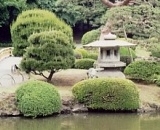
Ishidoro Shinjuku Gyoen |
Another feature that appeared with the tea-garden
style. Tsukubai is the name given to an
arrangement of stones set around a basin which is often fed by a bamboo
water pipe.
The central water basin is called a chozubachi. The original function
was for guests to the teahouse to purify themselves, washing their
hands. |
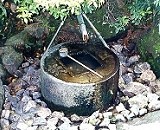
Chozubachi Ryoan-ji |
| The shishi odashi was
originally a device used by farmers to scare animals from their crops.
Water is drip fed to a pivoted length of bamboo which allows the upturned
end to collect water. When the quantity out weighs the balance it
drops and spills, it is when it swings back that the heavier end strikes
a specially placed stone producing the sharp sound. |
Functional, larger structures:
Consider - fencing, bridges, decking and for
the ambitious even a small teahouse. |
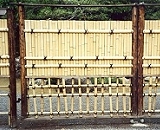 |
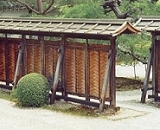 |
Fences
Highly artistic fences of bamboo and cedar
cladding can be seen around the entrances of many gardens. Decorative
panels can be obtained from some UK suppliers (see the resource list).
Or consider making your own. |
|
Shiba-rikyu Tokyo
|
Taizo-in Kyoto
|
|
Bridges
If your pond is big enough (and that does not
need to be very big) a bridge is something to definitely consider.
Again don't go for a pre-made, so called 'Japanese bridge' it will
probably be more Chinese. Consider building one yourself. |
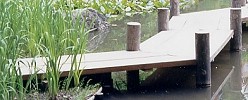 Korakuen Tokyo
Korakuen Tokyo |
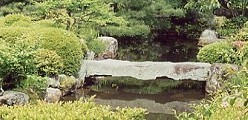
Togi-in Kyoto
Whilst selected slabs of rock are the preferred
material for small bridges it is not practical for home designs,
timber is and you can design your own.
|
The bridge over my own small
pond
is based on a design at Joju-in, Kyoto
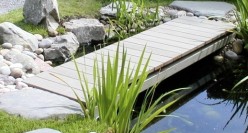 |
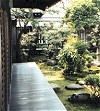 |
Decking
The verandas of temple halls provide a viewing
platform for the garden and help to frame the space. Decking between
house and garden can be similarly employed. |
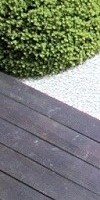 |
|
Inner garden at Chishaku-in Kyoto
|
Go for flat timber rather than
the purpose made ribbed material. And stay away from the coloured
stains, the emphasis again is on natural. I've used a dark oak to
contrast with the white gravel and greenery.
|
|


